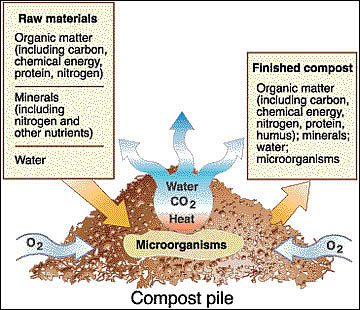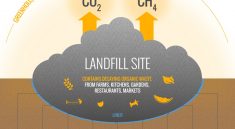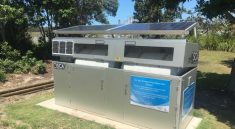Composting: How and what to compost, Right mix of “browns” and “greens”, Browns include leaves non glossy paper, Greens include coffee grounds vegetables fruit grass clippings
From NC State University Extension.
Rhonda Sherman.
“Backyard Composting of Yard, Garden, and Food Discards
Introduction
Instead of disposing of yard trimmings and kitchen scraps, you can compost them in your own backyard. Composting is an easy, fascinating, and natural way to recycle. Compost can be made from most organic materials such as leaves, kitchen scraps, and yard trimmings, and it can improve the health of your soil and plants. You can be as involved as you like with your compost pile: simply stack things up and wait for nature to take its course, or turn, water, and monitor the pile to speed up the process. When mixed with soil, compost increases the organic matter content, improves the physical properties of the soil, and supplies essential nutrients, enhancing the soil’s ability to support plant growth. Compost can also be applied to the soil surface to conserve moisture, control weeds, reduce erosion, improve appearance, and keep the soil from gaining or losing heat too rapidly. This publication explains how to build and maintain a compost pile and use the compost in your yard and garden.
Compostable Materials
Organic materials that can be composted are commonly characterized as “browns” and “greens.” Browns are sugar-rich carbon sources (carbonaceous) that provide energy to microorganisms, absorb excess moisture, and provide structure to your pile. Browns include dead fallen leaves, newspaper, straw, sawdust, napkins, cardboard, twigs, hay, dryer lint, and bark. Greens are protein-rich nitrogen sources (nitrogenous) that provide moisture to microorganisms. Greens include grass clippings, vegetables and fruit, coffee grounds, tea leaves, livestock manures, and alfalfa. Table 1 provides examples of organic materials that may be added to your compost bin.
| NITROGEN (GREEN) | CARBON (BROWN) |
|---|---|
| Grass clippings | Leaves, twigs, yard trimmings |
| Houseplant leaves | Yarn, thread, string, rope |
| Hair, fur, nail clippings, feathers | Paper rolls (towel, toilet, gift wrap) |
| Vegetables, fruits | Nut shells (not walnut) |
| Coffee grounds, filters | Cotton balls, swabs |
| Tea bags, leaves | Dryer lint |
| Egg & crustacean shells (rinsed) | Cotton, wool, silk, felt, hemp, linen, burlap |
| Old herbs, spices | Vacuum contents and floor sweepings |
| Flowers, dead blossoms | Straw, hay, corn cobs |
| Beer, wine making leftovers | Newspaper, non-glossy paper |
| Juice, beer, wine, dregs | Brewery hops |
| Freezer-burned vegetables, fruits | Loofahs |
| Aquarium water, algae, plants | Paper napkins and bags |
| Seaweed | Sawdust, wood bark, and chips |
| Herbivorous animal manure (rabbits, cows, sheep, chickens, horses) | Bamboo skewers and toothpicks |
| Pizza and cereal boxes, egg cartons | |
| Pencil shavings | |
| Paper baking cups | |
| Grains, cereal, crackers |
You can store food scraps in a container until you are ready to add them to your compost pile. Some people freeze food scraps in a container; others reuse a plastic container with a lid, or use a purchased compost kitchen container, and keep it under their kitchen sink or on the kitchen counter. Food scraps should be buried inside the pile to avoid attracting rodents.
Yard waste suitable for composting includes fallen tree leaves, grass clippings, straw, and non-woody plant trimmings. Although grass clippings can be composted, it is better to leave them on the lawn where they will decay and release nutrients, reducing the need for fertilizer. (See Cooperative Extension Service publication AG-69, Carolina Lawns.) When adding grass to a compost pile, mix it thoroughly with leaves so it does not compact and restrict airflow.
Newspaper and other types of paper can be composted, but the nitrogen content is low, which decreases the decomposition rate. If paper is composted, it should make up no more than 10% of the total weight of the material in the compost pile. It is better to recycle paper curbside or take it to a community collection site.
Some materials may pose a health hazard or create a nuisance and therefore should not be used to make compost. The following types of organic materials should not go into compost piles:
- Dog or cat feces and litter, and dirty diapers (may contain parasites and pathogens)
- Meat, fish, bones, fats, grease, lard, oils, eggs, or dairy products, such as butter, milk, yogurt, and sour cream (may create odors, attract rodents and flies)
- Yard trimmings treated with chemical pesticides (residual chemicals may kill beneficial composting organisms or affect plants where compost is placed)
- Diseased or insect-infested plants (diseases and insects may survive and be transferred to other plants)
- Black walnut tree leaves or twigs (release substances that might harm plants)
- Weeds that have gone to seed
- Weeds with invasive roots, such as dock weed, alligatorweed, or bermudagrass
- Used facial or toilet tissue (may contain pathogens)
- Charcoal ash or coal (resists decay and may contain substances harmful to plants)
- Pressure-treated lumber, pressed wood, plywood (contain toxic chemicals)
- Heavily coated paper (e.g., magazines, catalogs, wrapping paper, greeting cards with metallic inks, photographs)
- Wood ash (a handful or two may be added, but too much may harm microbes, slow the composting process, cause smelly ammonia gas releases, and reduce nitrogen)
- Pine needles (waxy coating resists decay)
Getting Started
Set up your compost pile or bin in a convenient location that is more than six feet away from your home or wooden structures. To help it retain moisture, place it in a shaded area within reach of a garden hose. The location should be a flat, open space that is protected from flooding or runoff to surface waters or wells. Keep the areas in front of and above the pile or bin clear so you can work without difficulty.
You do not need to use a bin to compost. Some choose to use a bin to keep the pile neat, help retain heat and moisture, or because they live in a neighborhood where a bin would be more appropriate than an open pile. Many people make their own compost bins using concrete blocks, wooden pallets, wire mesh, 55-gallon drums, or garbage cans. Others construct a three-compartment wooden bin using plans from the Internet. There are a variety of manufactured composting bins available, including enclosed, spherical, or tumbler styles. Although meat, fish, bones, and dairy should not be added to a compost pile or bin, they can be placed in an in-ground digester such as the Green Cone.
Composting Methods
There are two basic styles of composting: (1) single batch, where you add materials all at once to form a pile; and (2) continuous pile, where you add organic materials as they become available. Build your pile three to five feet high and at least three feet in diameter so it can become self-insulating to retain heat. Add four or five inches of carbonaceous materials (browns), then two or three inches of nitrogenous materials (greens), and keep alternating the layers. Another method is to thoroughly mix up browns and greens during loading. Be sure to thoroughly water each layer to ensure even moisture distribution. Toss in a handful of soil on each layer to introduce more microorganisms. Top the pile with four or five inches of carbonaceous materials to prevent flies and other pests and provide a filter for odors.
For a simple compost recipe, combine leaves, grass, food scraps, and coffee grounds at a 2-to-1 ratio mixture of browns and greens. To help get your compost pile hot, dust small amounts of one or more of the following (in meal form) on top of your greens: alfalfa, bone, hoof, soybean, canola, cottonseed, or blood. Adding a mixture of water and molasses, sugar, syrups, or flat soft drinks also helps to activate your compost pile.”
Read more:
https://content.ces.ncsu.edu/backyard-composting-of-yard-garden-and-food-discards




